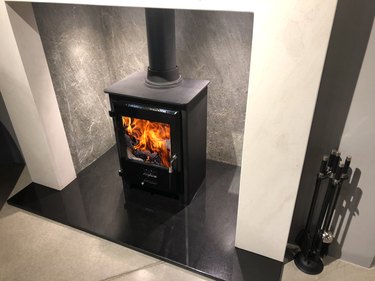
As energy costs escalate, heating your home in winter becomes a more expensive proposition. A wood-burning stove is one potential route to energy savings, especially if fuel sources are plentiful and accessible, but it must be installed properly, serviced annually, and run at the most efficient temperature — not too hot or too cool — to be a safe, viable heating option for you and your family.
Can Wood Stoves Get Too Hot?
Video of the Day
Absolutely. This is a risk with older wood stoves that may have flaws, such as damage or old welds. Generally, modern stoves have safety features to prevent them from getting too hot, which is called "overfiring." Explained simply, overfiring is akin to a blacksmith's metal forge, where the fire is stoked with enough fuel and oxygen so that it gets hot enough to melt steel.
Video of the Day
Modern wood stoves are typically equipped with a "high-burn" air-control device. This is handy when starting fresh fuel or trying to get a frigid home tolerably warm after a cold day out. It's fine to operate the stove at 500 to 600 degrees Fahrenheit to help get rid of creosote buildup and excess moisture, but after 20 to 30 minutes, the Town of Amherst suggests running the stove at the temperatures indicated by your user's manual or at 300 to 400 F per a stovepipe thermometer for the safest, most-efficient burn.
It's important to note that today's stoves allow for efficient control of airflow. By controlling how much air gets in, you dictate how slowly the wood burns. Burn wood too quickly and you're wasting heat; burn it too slowly and you risk creosote buildup. Once you use a stove for a while, you'll learn the ideal zone for heating your home efficiently and getting the most out of every log you burn.
Wood-Burning Stove Basics
All wood stoves are not created equally. Buying one should come down to its efficiency and the size of the space you're trying to heat. Because it's all about fire, the outside gets very hot as it's cast iron or steel that radiates the heat outward. So small children and pets need to stay away.
Installing a stove must be done safely. Some require as much as 3 feet of clearance from anything combustible, including unprotected walls. A heat shield installation can reduce this clearance, like a heat-rated tile wall. Manufacturers will tell you the required safe distance for the make and model of each stove.
Stove pipes and vents leading to the chimney are an important part of wood stove safety and efficiency. Pipe elbows reduce safety as they can promote creosote buildup, which can be dangerous if not cleaned out at least annually. Creosote is an unavoidable byproduct of burning wood, but drying or curing the wood properly and cleaning your stove and chimney once a year help to keep stoves running safely while also keeping heat output at the maximum efficiency.
What Wood Should You Burn?
The types of wood you burn contribute to how hot your stove is, how long the wood burns, and how well your home heats up. Hardwood and softwood are so named because of their density, and softwood is often less than ideal as it burns too quickly. Denser hardwoods not only weigh more and burn longer, but they also pack a higher BTU output.
Wood weighs far more when wet, so to "cure" wood for ideal burning conditions, you should split it, cover it, and store it off the ground, allowing it to dry for six months to a year before burning it. Otherwise, you're wasting wood and causing excess creosote buildup.
For a given species of wood, there's a relationship between the weight per cord, which is approximately 128 cubic feet of stacked wood, and the expected BTU output. For example, according to the Utah State University Forestry Extension, a cord of white oak weighs 4,200 pounds when cured, and its output is 29.1 million BTUs per cord. Compare that to, say, white pine, which has a heat output of 15.9 million BTUs per cord and weighs 2,250 pounds when cured.